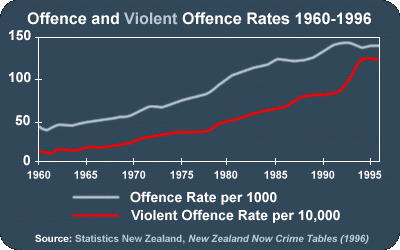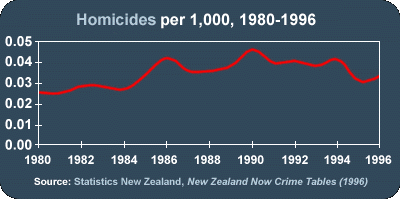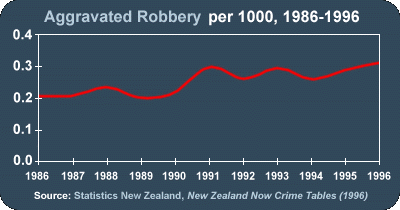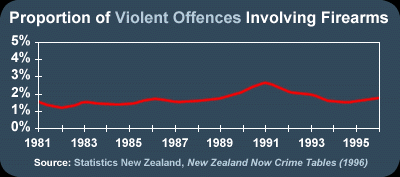| crime.files |
| |
 |
|

| crime.features |
| |
 |
|

| crime.resources |
| |
 |
|

| crime.co.nz |
| |
 |
|


|
 |  |

Numbers of Firearms Offences
There are some 4,000 Firearms offences each year, a level which is higher than was the case prior to 1980, but has not increased over the past six years.
In overall terms firearms play only a small part in inter-personal violence in New Zealand, being used in about 1.7 percent of all violent crime. It is, however, the most serious offences in which firearms are most likely to be used, and the consequences of firearm offending may be particularly grave.
In assessing the significance of present levels of firearm crime it is useful to consider whether its increase has been out of proportion with other violent crime, or has merely followed the general trend. The best available information suggests the latter.

As can be seen on this graph, violent crime rose steeply from 1993 to 1995 during the time when overall offending levelled off. Part of the rise may have been caused by changes in the law and reporting of domestic violence, but once that and other known factors are taken into account, the picture is still one of violent crime rising steeply through to 1991. From 1991 to 1996 there continued to be an increase but at lesser and more uneven rates.
The homicide rate has fallen since 1991, but aggravated robbery is still increasing:


Over the past 15 years firearm crime has increased at a slightly lower rate but generally in sympathy with violence overall. The following graph shows firearm offending remaining a relatively stable proportion of all violence.

In summary, increases in firearm crime have been less than in all violent crime but have followed its trend sufficiently closely to make it probable that firearm crime is a subset of violent crime, and that violence is leading firearm crime, not the reverse. The level of firearm crime is not increasing in such a way as to suggest a crisis, but it is sufficiently high to give grounds for concern and to require further endeavours to reduce it.
The two recent developments in firearm crime which give particular grounds for concern are the increased numbers of mass shootings, and evidence of increased readiness on the part of criminals to collect guns for use in criminal enterprises.
Mass Shootings
Although there is a deeply felt public abhorrence of mass killings and a great desire to do something about them, there is no consensus as to their causes, nor as to those measures which are likely to prevent their recurrence. [Part 3. 11 The report examines the roles of mental health, and of different types of firearms, especially military style firearms, in mass killings. It concludes that claims that mass killers typically have "a long history of mental health problems and violent behaviour" are not supported by the evidence. Rather, if there is any single characteristic which is common to most mass shooters, it is "social impotence", leading the person concerned to feel isolated from society and to respond with ever more bizarre and aggressive behaviour. [Part 6.1.5]
As to the types of weapons used, these have varied, but the report notes that the use of MSSAs for mass killings, although not a majority use, occurs in a much higher proportion of cases than those firearms have in the total gun population.
While on present information no realistic hope can be held out that action can be taken which will substantially affect the risk of further mass killings, the report does propose steps designed to reduce that risk to some degree. [Parts 6. 1. 1 and 6.1.5]
Relative Levels of Firearm Crime
In terms of relative levels of firearm crime, our gun crime rate is much less than the United States, but comparable with those in Canada and Australia, the Canadian figures for gun homicide being somewhat higher, probably because of its relatively high handgun population. [Part 3.4]
Gun Suicides
By far the majority of deaths from firearms are suicides. They make up 73 percent of Firearms deaths, firearm crime 16 percent, and accidents 9 percent. Recent increases in suicides have given New Zealand one of the highest rates of suicide, and particularly of youth suicide. The increase in gun suicides has been less than the overall increase, but is still at an all-time high. The special hazard of firearm suicide is that firearms are one of the most lethal methods of suicide, ranking in lethality just below hanging. Again there is no clear remedy, but steps proposed to reduce the availability of guns in the home should help. [Part 3.2]
Accidental Deaths and Injuries Involving Firearms
Accidental deaths from firearms have averaged nine per year since 1980, less than 1 percent of total accidental deaths, most of which are motor vehicle fatalities. Although accidental deaths and injuries from firearms had declined over earlier decades, they have shown no consistent increase or decrease in recent years. Lately the rate of accidental deaths in New Zealand has been significantly higher than that in Australia, where the accidental death rate has continued to fall. It is suggested we learn from Australian experience. [Part 3.3]
Degrees of Control of Firearms
A United Nations draft report released last month puts New Zealand towards the middle of the international scale of degrees of control save in the one respect of "a record keeping system for firearms", where our abandonment of that type of control puts us in the minority of countries without such systems. The report also shows that recent changes of attitude in New Zealand certainly do not run ahead of international concerns and desires to achieve closer control over firearms. [Part 4.4]
Changes in Attitude
Public Concerns
Submissions to this Review have shown a broadening and intensification of the concerns which had emerged in 1991 about the numbers of guns and the volume of gun crime. This was again expressed most strongly by women and women's organisations, but was broadly based.
The submissions also showed that there are still strong feelings on both sides of the argument. Most gun owners want to retain the limited restrictions and inexpensiveness of the present system. Most non-shooters express concerns about the level of violence within society and, perceiving firearms to be instrumental in this trend, argue for tighter gun controls. However, in the 1996 submissions, for the first time, a significant number of shooters declared their acceptance of the need to consider further controls. That change of view resembles those which preceded the major reforms of gun laws in Canada (1995) and Australia (1996).
Police Opinion
The internal review conducted by the police in May 1996 described the present system as "effective" but in need of some amendment to ensure that it "maintains its high level of integrity".
It was an early and central conclusion by this Review that the present system is fundamentally defective, and that arms control work has suffered from being repeatedly put behind other apparently more urgent police duties. That view was communicated to the Police as early as November 1996. In April 1997 the Police advised that further consideration had convinced them that there was need for a radical change. Later a formal "Police Response" forwarded to the Review on 2 May 1997 confirmed a major shift in the Police position, and that they accepted that the issues which had arisen during the Review, and "international trends in arms compliance", indicated the need for "a different category of control".
Overseas Opinion
Within the last two years Canada, Australia and Great Britain, have all legislated major reforms of their gun control systems, and the United Nations has set up a substantial committee structure dedicated to reducing arms trafficking and improving members' domestic arms controls.
In part this upsurge in interest has been a reaction to mass shootings, such as Dunblane and Port Arthur. In part it has come from the out-flow of surplus military equipment after the end of the cold war and the breakup of the USSR and the Warsaw Pact armies. Whatever the reason, there can be no doubt that such an upsurge has occurred, or that it shows no sign of abating, or that the signs of a movement towards closer gun controls observable here are at least as apparent in most other Western countries, and in such diverse societies as Germany, India and Japan which, with Australia and Canada, have been leading the charge at the United Nations.
|
 |
|

There are some 4,000 Firearms offences each year |
|